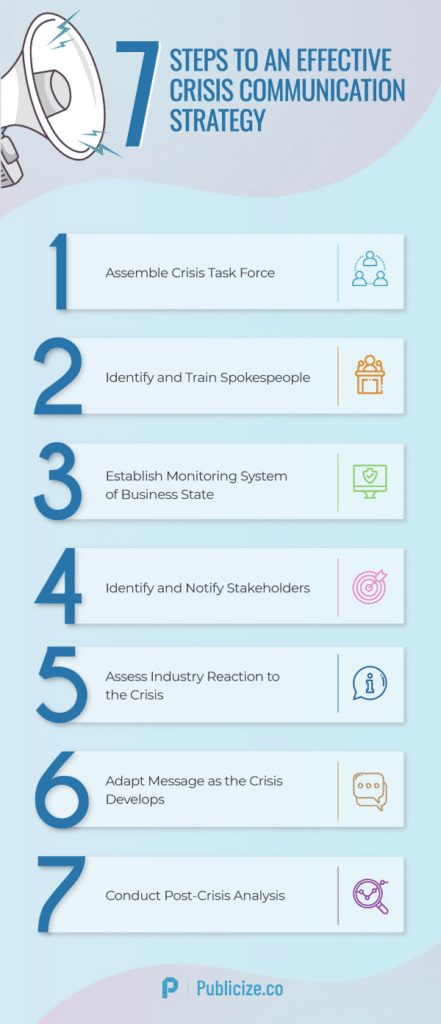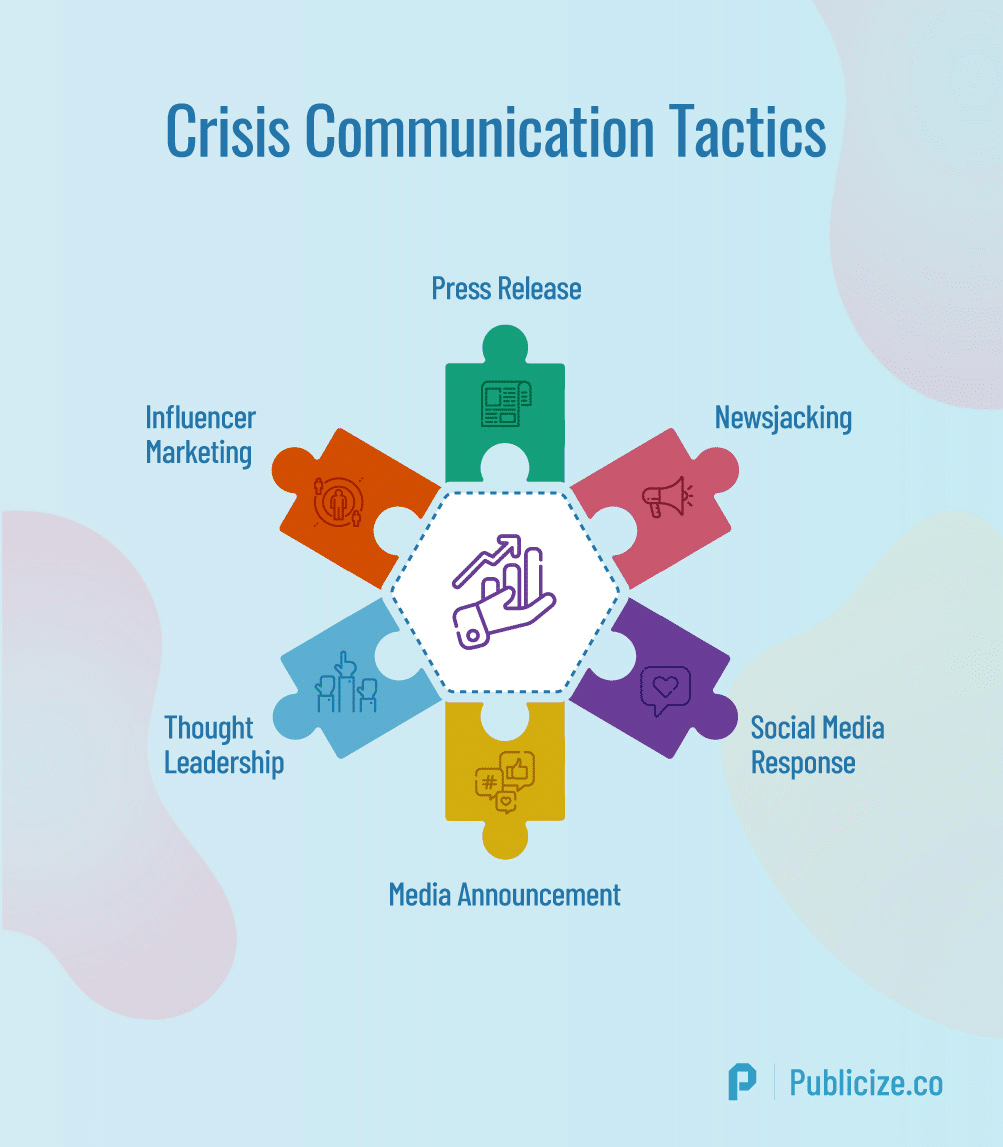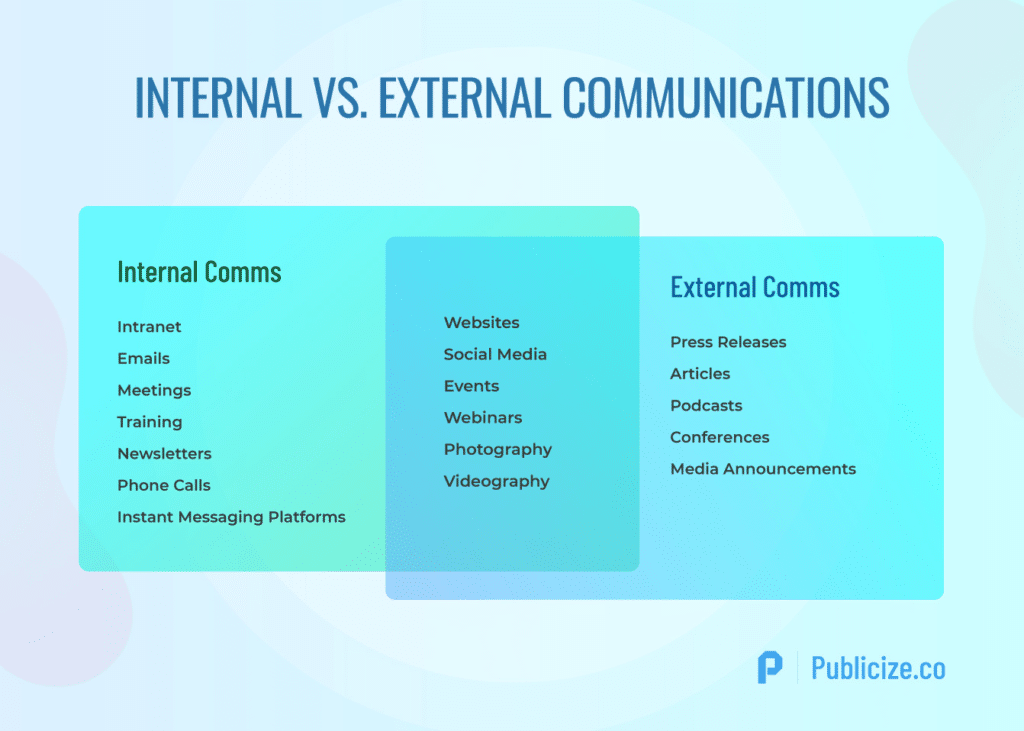If you want to listen to the audio version of The Ultimate Crisis Communication Management Guide, press play here.
‘Crisis’ can be somewhat of a loaded term.
Your first thoughts usually turn to natural disasters, economic crashes, or political conflict. Whilst all of these fall under the umbrella of a crisis communication management occupation, they don’t tell us the whole story.
Dispassionately speaking, crisis communication management is a blueprint for dealing with disruptions to business processes.
Crises are transformative forces in business, having a Darwinian effect on the companies involved. Whatever the nature of the crisis, they call for businesses to change strategy, target audience, and reallocate resources in a significant way. Sink or swim really is the name of the game, and for companies that want to come out as winners, a comprehensive crisis communication strategy is key.
As supply chains and commerce disruptions ensue, knowing how to make the right signals, and cut through the saturated noise from online media publications should be a business’ first port of call.
For this reason, we’ve created a comprehensive guide to help you navigate the unchartered waters of a crisis, whether its effects are in or out of your hands.
In this guide, we cover:
- What is Crisis Communication Management?
- Crisis Communication Strategy in 7 Steps
- Crisis Communication Tactics
- Internal Crisis Communications
Let’s get into it.
What is Crisis Communication Management?
There’s often confusion over the differences between crisis communications and crisis communication management.
As highlighted above, crisis management refers to the overarching process by which a company handles an emergency. Crisis management takes into account – resource management, risk management, strategic realignment, financial viability and communications. Crisis management can take on many different forms, meaning that the crisis management strategy will change based on the situation.
Crisis communications, on the other hand, specifically concerns itself with how you protect and manage public perception of your company, in the face of having your value or reputation scrutinized.
Whether it’s a self-inflicted crisis of your company’s brand image, or a circumstantial crisis like a natural or political disaster, the way your company carries itself in the eyes of the public is everything.
So, while crisis management involves several components other than the way your business communicates, your communication strategy is ultimately the most important, and informing piece of the jigsaw puzzle.
Now we’ve defined what crisis communication management is, let’s get into the steps you need to take to execute it effectively.
Crisis Communication Strategy in 7 Steps
The old cliche, if you fail to plan, plan to fail has never been more appropriate than during a crisis.
Having a holistic overview when creating your communication strategy allows your business to plan reactions to events that are consequential to the crisis, and mitigate against risk of responding incorrectly.
It’s not about keeping your calm in difficult moments. At least, that’s a really small piece of the pie. Your business’ crisis communication strategy should be indicative of its ability to get it’s own house in order, and align it’s internal and external signals that show empathy for the situation, and a clear road map for its resolution.
- Assemble a Crisis Communication Task Force
Before forming your communication task force, you need to identify the issues specific to this crisis to systematically approach each isolated problem. Not every crisis is the same, so recognizing which issues are directly impacting your company, and the best equipped team members to tackle these obstacles, will save you time and resources.
In addition, your crisis communication task force should be made up of your business’ most important figureheads. To give your communication strategy validity, it should come from the top.
Consider building your crisis communications team around the following individuals in your company:
-CEO or President: Ideally, depending on the size of your business, your CEO will spearhead its crisis communications task force. Having the company’s leader as a focal point sends signals of strength internally and externally.
-Head of HR: Highly important for maintaining effective internal control of your business, your head of HR should be acutely aware of how you’re delivering your crisis communication strategy. HR is your business’ internal mouthpiece. Addressing concerns of employees, be it employment, altered working conditions, or even strategy will first fall under HR’s responsibilities.
-Customer Relationship Manager: Your customer relationship manager will offer support to existing clients, should they have concerns about the status of your business. Not only should they be involved so they can correctly transmit the correct information to customers, but the customer relationship manager should have good insights into how your customers will react to certain communication tactics.
-Head of PR or PR Consultant: The importance of digital PR can’t be stated enough. If they’re not already, your PR executives should be rallying its department to find effective solutions to the crisis. If you’re without a PR department, hiring an experienced PR consultant should be the next move your company makes.
-Legal Advisor: Legal council will allow you to establish parameters around your crisis communications strategy. Depending on the type of crisis you find yourself in, a lawyer can help you form the semantics of your external communications. For example, the words ‘no comment’ can often be a death sentence for businesses in moments of scandal. - Identify and Train Spokespeople
Your company spokesperson not only needs to be a strong public speaker, but know your crisis communications strategy inside out. For this reason, your spokesperson should be a member of your crisis communication task force.
A confident communicator, both written and verbal, lets all stakeholders know that your business intends to come out stronger on the other side of adversity, and fully make amends for any wrongdoing. If your crisis is during a pandemic, for example, you’ll want your spokesperson to demonstrate how your company is still relevant. If risks to people’s health is the forefront of conversation, then it becomes difficult to foster interest in a B2B marketplace. That’s where your spokesperson comes in. They have to shape the narrative to show why people should maintain interest in your product or service.
Concerning media training, there’s an outdated misconception that this is the basis for all PR. While it’s certainly an important aspect, it covers only a small portion of what good PR can do for your company. Being prepared to speak at a press conference is one thing, but your PR efforts shouldn’t stop there. - Establish Monitoring System of Business State
Monitoring the health of your company shouldn’t be reduced to occasional glances at a profit and loss graph. The more granular your analysis of the business’ status, the more chance you’ve got of making it through a crisis. Gone are the days where a qualitative analysis of what a broadsheet publication says about your business would suffice. You need to arm yourself with some powerful digital marketing tools to understand what’s really going on.
If your business wants to stand a chance of keeping its digital footprint, keeping a close eye on its Google Analytics is an absolute necessity. Google Analytics helps you understand how people behave on your website, and can give vital indications as to their current interests and needs. Everything has a knock on effect: A reduction in traffic can lead to fewer conversions, resulting in fewer sales. Understand how people interact with your brand and understand how you should be communicating with them.
SEO software such as SEMRush or AHRefs allow you to investigate what people are searching for. Platforms such as these can be the basis for the words you use to communicate with your target audience during a crisis, so it’s important to understand what your audience is searching for, and how you can solve its queries.
Finally, customer relationship management (CRM) software such as Salesforce monitors the follow of existing and new customers in and out of our sales funnel. Keeping track of the status of your prospective and current client base is vital during a crisis, and can tell you when you need to move fast to save customers from dropping out of the funnel or abandoning your service.
These analytics tools will paint a picture of the efficacy of your crisis communications strategy, and how it should be tweaked to compliment changing circumstances. - Identify and Notify Stakeholders
You may think you already know your company’s stakeholders. This might be true, but during a crisis, it’s especially important to revise this, as the events leading up to the current situation could mean you have unforeseen, interested parties.
Firstly, your employees should be considered your most important stakeholders.
Why?
Because each one is your representative during the crisis. Bringing disgruntled employees on-side and ensuring that there is informational symmetry throughout the company is step 1.
Coming back to new stakeholders, you already know who your target audience is, and the profile of your existing customers. But how has the crisis affected your industry, and has it opened up new avenues to target a different profile of person? Make sure you don’t miss out on an opportunity to target new potential customers by doing a comprehensive analysis of the effects of market change to you and your competitors. - Assess Industry Reaction to the Crisis
Gauging how industry influencers and stakeholders are responding to the crisis can help you avoid some PR catastrophes. Now is not the time to be shooting from the hip, and decisions need to be informed not only by your internal knowledge but what by others are doing to handle the situation.
If the crisis is specific to your company’s actions, such as a corporate misconduct allegation, your crisis communications task force must keep abreast of public opinion. Be truthful, provide information that supports your company, and don’t let the media become your enemy.
However, if the crisis is generic to all businesses in your industry, the fact that you’re all in the same boat can work to your advantage. Taking stock of what your rivals are doing to fight through uncertain times allows you to filter good and bad communication tactics from your own communications strategy. American Apparel brilliantly demonstrated what not to do when executing a communications strategy in a crisis, by introducing a sale during Hurricane Katrina, and distastefully using the advert strapline “In case you’re bored during the storm”. - Adapt Message As the Crisis Develops
Closely tied to the information you’ll procure in steps 3 and 5, tailoring your message to fit how the crisis manifests itself tells your target audience and industry influencers that your business is aware.
Developing event-specific communications, be it through a press release, a video, or an article, is evidence to your stakeholders that the ramifications of the crisis remain your sole concern.
The size of the crisis could mean that addressing all its moving parts is virtually impossible. Remember, though, it’s not necessarily your company’s role to talk about every eventuality. By keeping your messages simple, and your focus on the key crisis points, stakeholders will get your point. As well as respecting some clarity during a chaotic period.
Your messages don’t require a lot of time, either. A simple tweet or banner on your website can be more powerful than hosting a national press conference. - Conduct Post-Crisis Analysis
Doing a post-mortem once the dust has settled is not a throw-away step. It’s fundamental to how your business evolves and prospers from the crisis it’s endured.
If your response to the question ‘what did we learn?’is ‘nothing’, then you’ve not evaluated your company’s actions successfully. Even in times where events are out of your hands, there are always lessons to be learned as a business.
Straight after a crisis, it’s good practice to talk with your team members, and get their perspectives on how your business handled the crisis. Not only will it build team confidence, it’s the best way to field ideas for how your business can improve in the future.
Additionally, you should consider the benchmarks you set during the crisis. And don’t restrict this to purely thinking about response time. Also consider how much output was required by content like press releases and blog posts. Ask yourself if these objectives were attainable under pressure, and if they can inform how you set goals going forward.
Most crucially, update your communications plan to include future potential crises. By taking the feedback from your employees and the analysis of your strategy’s success, you can be sure you’ve taken valuable insights from the experience that will allow your company to grow.

Crisis Communication Tactics
So, we’ve covered the 7 steps for creating a robust crisis communication strategy. Now it’s time to discuss the tactics that will provide the ammunition for executing your communications plan.
As we’ve said previously, your crisis communication strategy should identify and isolate the specific ways in which your business is affected by the crisis. As endearing as it would be to write a press release about how sad your company is for the victims of a natural disaster, it’s probably not what readers want to read. People care most about what you do as a company to combat a crisis, and resolve the problems that surround it.
To tailor your crisis communications plan for each type of situation, check out our list of communication tactics below:
Press Release
Press releases are traditionally the most common method of external communication in a crisis.
They’re particularly effective when outline your business’ response to a natural disaster, or an event that compromises your business’ integrity.
When writing a press release in a crisis, it’s important to open with key information and get to the meat of the matter. The purpose of a press release is to inform rather than entertain, so a cold hard summary of the situation is fine.
Meanwhile, clearly stating facts allows the reader to contextualize what your announcement is about. Finally, a neutral tone that avoids the use of emotive language is preferable. For more information on writing press releases during a crisis, read our handy article here
Media Announcement
A media announcement can easily be conflated with a press release, yet the two are distinct from one another. While press releases usually appear as a brief written statement, media announcements can be more diverse. For example, a video of your company’s spokesperson, or a virtual press conference.
A media announcement can be a great tool for proving your value during moments of difficulty for your shareholders. Also, video content can further illustrate the human element of your company, and is more appropriate for highlighting your company’s emotional reaction to a crisis than a press release.
The key to a successful media announcement during a crisis is to prepare your key talking points, and do your homework if you need to answer questions. Ensuring your spokesperson is media trained is a best practice here.
Social Media Responses
Social media interactions might sound like a frivolous add-on, but they can be pivotal tools to refining your crisis communications with your target audience.
Depending on your audience demographics, their most likely source of new information will be on social media platforms like Twitter and Instagram. Social media’s relevance is becoming less and less deniable, and companies are beginning to invest more and more resources into making sure it’s managed correctly.
Tweets, Instagram posts, or even LinkedIn announcements serve as great vehicles for showing your company’s adaptability in a crisis. You can also react to breaking news on social media platforms, giving your company the ability to shape the narrative around a particular topic.
Newsjacking
Newsjacking has been around since the dawn of the internet, and can be a useful tool for getting some needed exposure during a crisis.
Not particularly useful in a crisis that’s self-inflicted, newsjacking best aids companies who are struggling to break through saturated online content about a globally impactful event.
A word of warning here.
Newsjacking should be done in good taste, and not appear to exploit the crisis purely for your business’ gain. Celeb Boutique decided to riff off a crisis in Colorado in an attempt to sell dresses, and caught some severe online blow back as a result.
If you’re wondering how to newsjack tastefully, there are certainly some shining examples to follow. American Airlines tweeted its support for the LGBTQ+ community with its backing regarding marriage equality and diversity.
Thought Leadership
During any crisis, retaining the respect of your industry peers and your target audience is crucial. The best way to foster this is by proving your business to be a thought leader.
Thought leadership describes how revered businesses are perceived in a given sphere of influence. Thought leaders’ expertise is demonstrated by the work they produce, and how their ideas drive progress in their industry.
Attaining thought leadership is a long-tail crisis communication tactic, and might feel redundant if you’re looking for a quick-fix solution. However, the individual tactics for gaining thought-leader status can still provide some tangible results during a moment of crisis.
Developing the following communication tactics will help establish you as a thought leader:
- Online collaborations with other organizations (ebooks, joint-service launch)
- Consistently create valuable owned media (blog posts, webinars)
- Guest posts on top tier publications
- Be a guest on industry-respected podcasts
- Give opinions where appropriate on your social media channels around the crisis.

Influencer Marketing
Influencer marketing was a fairly unknown concept five years ago. Today, platforms like Instagram provide not only business opportunities but self-employment opportunities to individuals with popular accounts.
As a tool for boosting your business’ exposure, influencer marketing can validate your business in times of uncertainty and reaffirm your relevance. An endorsement from a famous celebrity or industry figurehead keeps your company in the public eye, while communicating your brand’s credibility.
If you’re unconvinced about the return on investment, 89% of marketers say their returns on influencer marketing is at least as good if not better than other channels to market their business.
Be careful to select the correct influencer to advertise your brand to the public, as an endorsement from the wrong person could send the wrong message to your target audience.
If you need help finding the right influencer for your industry, read our handy blog post about making the correct choice here.
Internal Crisis Communication
We’ve spoken a lot about the importance of external communications above, but what about your internal channels?
Having a clear stream of continuous internal communication is the first step to managing any crisis. Not only do internal communications keep your staff informed of company actions during times of pressure, it keeps your employees engaged and helps maintain a level of calm within your different departments.
An effective internal communication strategy should give every person within your business a holistic overview of how the business has been affected by the crisis, and the strategy that’s been put in place to fight it. Meanwhile, opening internal verbal and written channels in your business’ network empowers your workforce to give valuable feedback, and constructively criticize your crisis communication tactics.
That’s all well and good but, what do you need to implement an awesome internal communications strategy?
Here are the moves your company should make to have a cohesive internal communication strategy:
1. Get feedback about your current internal communication strategy from staff
Ask your employees their feelings about the current internal communication strategy through a survey or a feedback form. This way, you can demonstrate you value staff inputs and find out the optimal way to transmit information to them.
Moreover, get their opinion on your company’s initial reaction to the crisis. If you’ve had to make tough decisions, like downsizing or taking away benefits, you can gauge company morale with taking in some of their thoughts and feelings.
2. Keep your internal communication objectives SMART
If your goal is to have complete information symmetry from the top to the bottom of your company, fugetaboutit.
Keep communication improvements realistic, measurable, and achievable in a short space of time. If you’re having trouble organizing your objectives to be attainable, read more about SMART goals here.
3. Know the tools you have available to your company
Do a brief analysis of the resources that you need to optimize your internal communications.
Instant messaging platforms like Slack fuel collaboration between teams and ensure the right information is recorded. Also, project management solutions like Trello keep you on top of your task list and inform you of people’s workload. Best of all, both of these digital tools are free to use.
If your business’ crisis has forced you to adjust to a remote working environment, platforms like Slack and Trello keep you connected at all times, minimizing the risk of breakdowns in communications.
4. Don’t overload employees with information
While employees need to be kept in the loop with business ongoings during a crisis, overwhelming them with non-essential communication can cause your most important announcements to be lost.
Depending on the size and type of business you operate, your members of staff are likely inundated with updates and changes to their daily schedule. A concise overview of your communication strategy leaves people aware while not exhausting their ability to retain important information.
5. Have unity between your internal and external communications
A unified internal and external communications strategy is your only feasible crisis communication solution.
Though your methods of communication can differ greatly inside your organization from outside, your message should remain consistent. If your stakeholders see asymmetry between the signals your different communication channels are sending, it erodes confidence and trust in your brand.
To avoid this, make a list of your internal, external, and overlapping communications, and create a plan for how you’ll keep your message constant throughout.

Wrapping Up
When your company finds itself in a crisis, it can be overwhelming.
With that being said, remember the following – every crisis is different, so isolating the particular ways that your business is affected by the crisis is the best solution to overcoming it.
By assembling a solid crisis team, aligning your realistic business objectives, and ensuring consistency between internal and external comms, you’ll give your business the best possible chance of coming out stronger on the other side of a crisis.











